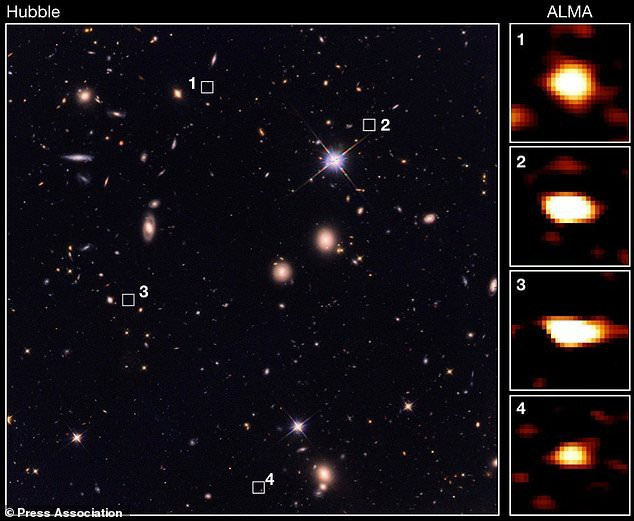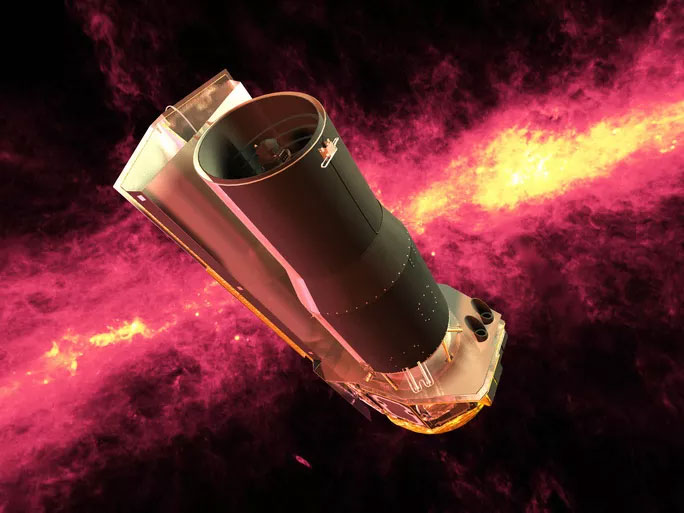Find out the great world of 'specter' galaxies
Japanese scientists have found a way to reach the invisible super galaxies that NASA's Hubble space hunter must also give up.
A series of state-of-the-art space observatories around the world joined forces in the research of a group of scientists led by Dr. Tao Wang from Tokyo University (Japan) to discover the "treasure" of ancient galaxies. great. These are the 39 most great galaxies known to man, very ancient and opaque like ghosts , invisible before NASA's Hubble Space Telescope.

4 out of 39 "specter" galaxies from the image of ALMA (right) are marked with a square in the Hubble space photograph.They were completely invisible to NASA's "Hubble hunter" - (photo: HUBBLE / ALMA / PA).
This galaxy population was born in the first 2 billion years in the history of the 13.7 billion years of the universe and carries many strange features."These things were previously invisible to us. This finding brings many contrasts with the current models that describe the evolutionary stages of the universe, helping us add many missing details until now "- Dr. Wang said.
The authors also revealed that this great galaxy population will provide many interesting details about the distribution of dark matter - which exists a lot in the universe but is also one of the most mysterious and mysterious things. . They also possess ancient and scary super mass black holes.
To identify them, scientists have to pair many unclear pieces of data from many observatories around the world, including famous names such as Atacama Large Millimeter / submillimeter Array (ALMA) placed on the desert. Chile's Atacama Desert with a powerful radio telescope system, Very Large Telescope System (Chile), Spitzer Space Telescope (NASA) .

Spitzer Space Telescope (NASA) . (photo: NASA).
In particular, infrared data of Spitzer Space Telescope revealed the first fuzzy "ghosts" from this mysterious world.
The reason they are invisible to most telescopes is because these galaxies are so far away, light to Earth is only very weak and stretched. It is this stretch of light that will help scientists calculate how far we are, thus calculating the exact age of these ancient galaxies.

Part of ALMA's living system consists of 66 modern telescopes - (photo: ALMA).
And they can really just be ghosts. Maybe they are more than 10 billion light-years away and the precious images just observed are images of the past universe more than 10 billion years ago.
According to the article published in the journal Nature, research on this "specter" galaxy world continues. In the near future, James Webb Space Telescope of NASA / ESA / CSA (US, European and Canadian space agencies) scheduled to launch in 2021 will participate in research on "primitive monsters". This, according to the authors' way of speaking.
- The specter of the galaxy
- Nearly 900 galaxies hidden behind the Milky Way
- The brightest galaxy in the universe is evaporating
- The mystery of the dead galaxies
- Detecting a group of 'ghost galaxies'
- Discover 'living fossil' galaxies in the universe
- Discover the birth of ancient galaxies
- The Milky Way is lighter than we thought
- Stunned disclosure of technology to identify cosmic galaxies
- Clash between two galaxies
- Close up of galactic conflict
- The galaxy eats each other to grow
 Van Allen's belt and evidence that the Apollo 11 mission to the Moon was myth
Van Allen's belt and evidence that the Apollo 11 mission to the Moon was myth The levels of civilization in the universe (Kardashev scale)
The levels of civilization in the universe (Kardashev scale) Today Mars, the sun and the Earth are aligned
Today Mars, the sun and the Earth are aligned The Amazon owner announced a secret plan to build a space base for thousands of people
The Amazon owner announced a secret plan to build a space base for thousands of people